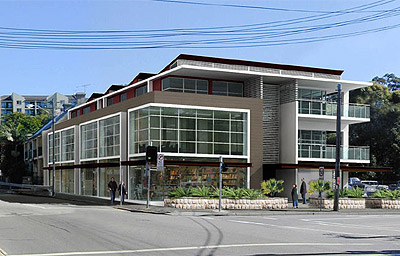
This is due to a new provision within the Building Code of Australia (May 2011) and Disability (access to premises) standard.
The reference causing all the grief in the BCA is;
Table D3.1 Requirements for access for people with a disability
Class 2 Common areas
From a pedestrian entrance required to be accessible to at least 1 floor containing sole-occupancy units and to the entrance doorway of each sole-occupancy unit located on that level.
What does this mean?
In each of the five cases above, class 2 residential apartments were located above either a class 5, 6 or combination of both tenancy with stair access only provided to the above floors. Since May 2011 when the premises standard was incorporated within the Victorian Building Regulations and BCA access by means of a lift must be provided.
Access must then be provided to the entrance door of each sole occupancy unit (note it does not say through the door). This then triggers circulation access requirements from the lifts to apartment doors that usually requires internal redesigns. The relevant clauses are:
In each of the above mentioned five projects, all class two apartments were on level one and above without a lift. All developments had been issued town planning permits by the relevant local government authority.
Unlike NSW where the majority of local government authorities that require town planning applications (development approvals) be signed off by an access consultant that are accredited by the Association of Consultants in Access inc. only the City or Moreland and City of Whittlesea require such assessments in Victoria.
For NSW, this case set the benchmark and changed local governments approach to accessibility was due to the approval by the local government of a cinema complex that was not accessible. The following are extracts from the hearing at the Human Rights Commission.
DATE OF HEARING: 11 February 2000
DATE OF DECISION: 12 May 2000
In approving a development that was not accessible, it follows that the complaint against the Council has been substantiated in that in terms of section 122, it permitted the development without requiring compliance with the access requirements of the DDA.
RELIEF
Section 103 of the DDA catalogues the powers of the Commission after inquiry. It was submitted, inter alia, by the complainant that because of its breach of the DDA the Council should be ordered to make a public apology to the complainant and to those whom he was representing and further that monetary compensation should be ordered.
In my view neither form of relief is appropriate in this case. The Council clearly identified the relevant issue which it had to consider and it is accepted that the relevant belief concerning the operator’s position was honestly held by the Council. It fails in its defence because of the reasonableness issue. In those circumstances the only appropriate relief is to declare pursuant to section 103(1)(b)(i) of the DDA that the complaint against the Council has been substantiated and that the Council in approving the application permitted a breach of the DDA by the operator and that in so doing its act was unlawful.
A fully summary of the complaint and findings can be obtained here www.humanrights.gov.au/ian-cooper-behalf-north-coast-dial-inc-v-coffs-harbour-city-council
It is the opinion of our office that it will only be a matter of time whereby a council will face legal action from a developer due to approving a development that cannot obtain a building approval. The costs associated with redesign including prolongation and consultants fees on a project is significant.
Who should ware this cost? The projects architect, developer or the local government authority that applied planning restrictions to the development and ultimately issued a town planning approval.
It will be very interesting to see what happens over the coming years. We know five developers from this year who are considering options now their developments have been delayed.